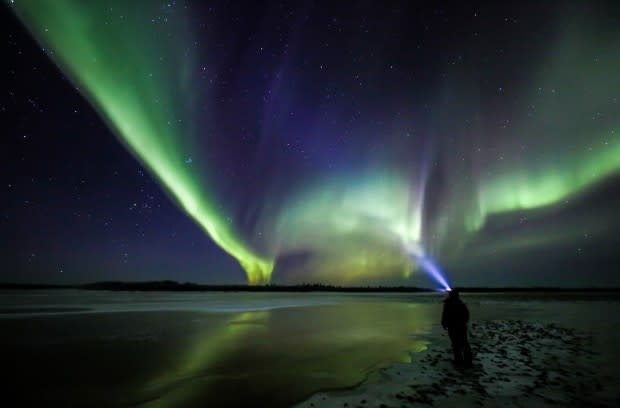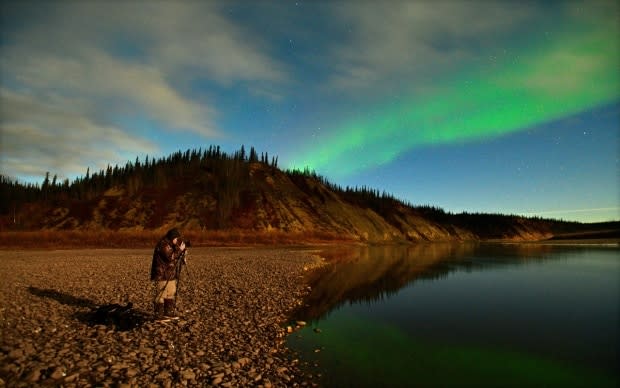How to get that spectacular photo of the northern lights
What's the first thing you need, to capture the perfect photo of the night sky?
"Patience. You've got to have some patience," says Whitehorse photographer Mark Kelly, who's got an impressive collection of spectacular night-sky photos.
"These shots take a long time ... you need to have a Thermos of coffee, and a good attitude."
This weekend, Kelly is holding some photography workshops as part of the annual Dark Sky Festival in Yukon's Kluane National Park, hosted by Parks Canada and the Yukon Astronomical Society.
"This is a great time of year for aurora shooting. What I love about it is that sometimes the mountains are capped in snow, the water is still open so you can get reflections in the lake, and it's usually still, at late night," he said.

Here are some of Kelly's simple tips for capturing the constellations, or avoiding an aurora blurry-alis.
Stop the shaking
"The biggest trick, actually, is having a good tripod," Kelly said. "It doesn't have to be expensive, but it ought to be solid and strong."
Getting a good shot in low-light conditions means opening your shutter for several seconds. That means you have to keep your camera as still as possible, lest those twinkling stars become amorphous blobs or streaks, and the aurora borealis becomes an unremarkable smudge of colour.
"You have to stabilize your phone. You can't just hold it, no matter how still we think we are. Our heart is still beating," Kelly said.

He also suggests using a cable or a timer to actually take the shot, so you don't have to touch the camera and risk moving it.
Adjust your settings
Once you're set up with a tripod, it's important to turn off the camera's image stabilization or vibration reduction (VR) tool. When the VR is on, Kelly says, it can create a vibration down the tripod legs that make a shot blurry.
"I've had lots of folks in my classes say, 'I don't get it, it's blurry!' And I'll walk over and say, 'Well, is your VR off?' and I'll click that off. The next thing you know, you've got a nice crisp shot."
Kelly recommends using a high ISO — say, 1600 — but not too high. He said he tries not to shoot over 3200, to avoid noise in a long-exposure shot. Noise gives an image an uneven, grainy look.
Use the widest aperture possible that your lens has, he says. And don't keep the shutter open too long.
"Anything longer than 25 seconds and your stars will start to streak," he said.
For aurora shots, even 25 seconds might be too long, and result in overexposure.

"Don't forget, aurora is dynamic ... on a really bright night, you might get a big white or green streak and blow it out. All of a sudden it's too bright."
Finally, he says to use stars as your focal point for expansive sky shots.
"You do always have a little bit of foreground. And if you don't focus on the star, the stars won't appear as a pinprick, they'll appear sort of soft when you go to enlarge it.
"Pick the brightest star in the sky, usually for us it's Polaris, and focus on that. And then turn your auto-focus off, and then re-compose your frame.
Get out of town
Most important, Kelly says, is finding a good dark sky.
"The hardest part is actually not having other ambient light bother you. So like, lights of a city," Kelly said.
In other words, it's best to get out of town — unless you live in a very small town.
"If you live in Pelly Crossing, you can do it out your back door," he said.

Most of Yukon is relatively free from light pollution, except around Whitehorse. Kelly said he used to be able to drive not far out of town to find a nice dark sky — but not anymore.
"Now the glow of the city is quite clear and obvious," he said.
He says Kluane Park is an ideal place to try one's hand at night sky photography. He says getting spectacular shots always involves some trial-and-error, but it's worth the effort.
"Get a nice spot that you have a nice foreground, and a good view of the sky, and your lawn chair and your flask and your tripod and your camera, and yeah — give it a go."


